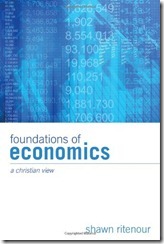 Chapter 3 of Shawn Ritenour’s Foundations of Economics argues that the law of marginal utility and the law of (diminishing) returns are the most fundamental laws of human action.
Chapter 3 of Shawn Ritenour’s Foundations of Economics argues that the law of marginal utility and the law of (diminishing) returns are the most fundamental laws of human action.
The chapter opens with a presentation of the diamonds-water paradox discussed by Adam Smith and mentioned in several of the other works on which I’ve already posted in this series. This paradox of value ultimately stumped Smith, but Ritenour writes that the solution is attainable if three principles from the preceding chapter are borne in mind: value is subjective, action is an exchange of one state for another, and people value means according to the value of their ends.
From these principles Ritenour derives the law of marginal utility: because people choose between specific, “marginal” units of goods (the marginal unit is the smallest unit relevant to action) and not entire categories of goods, they may assign greater value to a marginal unit of a “less useful” good like diamonds than to one of a “more useful” good like water when the “more useful” good is in greater supply. Thus your millionth gallon of water may have a marginal value of zero to you whereas your first diamond may have great value.
The law of marginal utility applies no matter how many goods one is considering in a selection process, but the chapter keeps things simple. Ritenour uses the example of a rancher purchasing livestock. Perhaps she wants four cows and three horses, but can’t afford them all. She doesn’t have to choose all cows or all horses; maybe her funds will allow her to buy four animals, and she’ll choose three cows and one horse.
In rebuttal to Christian thinkers who claim that this sort of analysis cannot be employed to explain choices in the spiritual realm, Ritenour states that although not every choice carries equal moral weight, finite resources must still be allocated according to an individual’s ranking of preferences (at the margin). The same $20 cannot both buy a shirt for you and also be donated to a charity that feeds the needy.
Next, Ritenour discusses the law of returns. Using the example of a farmer fertilizing his fields, he points out that as the farmer continues to add fertilizer to the same plot of land, at some point the effectiveness of each additional unit of fertilizer will begin to diminish. Stated more generally, “as the quantity of the general factor used increases, while the quantity of complementary factors remains constant, a point is reached where the Marginal Physical Product (MPP) of the variable factor begins to decrease.” In a finite universe, this law must necessarily be true in all cases.
With the laws of marginal utility and returns established, Ritenour has prepared the ground for discussion of property, exchange, and the division of labor in the next chapter.
